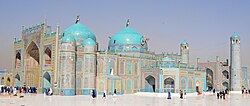
Back الهندوسية في أفغانستان Arabic আফগানিস্তানে হিন্দুধর্ম Bengali/Bangla Hinduisme a l'Afganistan Catalan Hinduismo en Afganistán Spanish آئین هندو در افغانستان Persian अफगानिस्तान में हिन्दू धर्म Hindi Hinduisme di Afganistan ID अफगाणिस्तानमधील हिंदू धर्म Marathi अफगानिस्तानमा हिन्दु धर्म Nepali ਅਫਗਾਨਿਸਤਾਨ ਵਿਚ ਹਿੰਦੂ ਧਰਮ Punjabi
 | |
| Total population | |
|---|---|
| 60 (2022)[1] | |
| Regions with significant populations | |
| Larger diaspora in India, Germany, United States, United Kingdom, and Canada[2] | |
| Religions | |
| Hinduism[3] | |
| Languages | |
| Dari, Pashto, Hindko, Punjabi, Sindhi, and Hindustani (Urdu-Hindi) |
| Part of a series of articles on |
| Religion in Afghanistan |
|---|
 |
| Majority |
| Sunni Islam |
| Minority |
| Historic/Extinct |
| Controversy |
Hinduism in Afghanistan is practiced by a very small minority of Afghans, about 30–40 individuals as of 2021,[1][4][5] who live mostly in the cities of Kabul and Jalalabad. Afghan Hindus are ethnically Pashtun,[6] Hindkowan (Hindki), Punjabi, or Sindhi and primarily speak Dari, Pashto, Hindko, Punjabi, Sindhi, and Hindustani (Hindi-Urdu).
Before the Islamic conquest of Afghanistan, the Afghan people were multi-religious.[7] Religious persecution, discrimination, and religious conversions of Hindus in Afghanistan perpetrated by Muslims, has caused the Afghan Hindus, along with Buddhist and Sikh population, to dwindle from Afghanistan.[8]
Prior to the contemporary conflict that began in 1978, Hindus lived across Afghanistan, notably concentrated in major urban centres such as Kabul, Kandahar, Jalalabad, Herat, Mazar-i-Sharif, Kunduz, Ghazni, and Khost.[9][10] Additionally, significant rural population concentrations in villages traditionally existed in eastern portions of the country as documented by British travelers Jonas Hanway and George Forster in the 18th century,[a] however, various exoduses and migration to urban regions of the country and eastwards to British India occurred throughout the 19th and 20th centuries as a result of occasional violence and conflict.[b][c][d][e]
According to the European Union Agency for Asylum (EUAA), the number of Hindus in Afghanistan has steadily declined over the past few decades.[11] During the mid 20th century, in the 1970s, approximately 280,000 Hindus lived in Afghanistan;[f] by 1992, prior to the fall of the government, the population was approximately 88,000,[g] while by the start of 2021 roughly 160 Hindus remained,[h] and by the end of the same year, the population reportedly declined below 50 persons.[11]
- ^ a b "Afghan Sikhs, Hindus meet Taliban officials, are assured of safety". The Indian Express. Archived from the original on 27 June 2022 – via MSN.
Speaking to The Indian Express over the phone from Kabul, Gurnam Singh, president of the Gurdwara Dashmesh Pita Sri Guru Gobind Singh ji Singh Sabha Karte Parwan, said around 300 people — 280 Sikhs and 30-40 Hindus — have taken shelter at the gurdwara since the Taliban started taking over provinces of Afghanistan.
- ^ Country Policy and Information Note: Afghanistan: Hindus and Sikhs (PDF). Home Office, United Kingdom (Report). 6.0. March 2021. p. 15. Retrieved 17 May 2021.
- ^ Singh, Manpreet (22 August 2014). "Dark days continue for Sikhs and Hindus in Afghanistan". Hindustan Times. Retrieved 13 February 2021.
- ^ a b c d Goyal, Divya (28 July 2020). "Sikhs and Hindus of Afghanistan — how many remain, why they want to leave". The Indian Express. Archived from the original on 6 February 2021. Retrieved 13 February 2021.
- ^ "3.14.3. Hindus and Sikhs". European Union Agency for Asylum. Archived from the original on 17 November 2023. Retrieved 17 November 2023.
- ^ Ali, Tariq (2003). The clash of fundamentalisms: crusades, jihads and modernity. Verso. p. 20. ISBN 978-1-85984-457-1. Retrieved 20 April 2008.
The friends from Peshawar would speak of Hindu and Sikh Pashtuns who had migrated to India. In the tribal areas – the no man's land between Afghanistan and Pakistan – quite a few Hindus stayed on and were protected by the tribal codes. The same was true in Afghanistan itself (till the mujahidin and the Taliban arrived).
- ^ Wink, André (2002). Al-Hind, the Making of the Indo-Islamic World: Early Medieval India and the Expansion of Islam 7Th-11th Centuries. BRILL. ISBN 978-0-391-04173-8.
- ^ Hutter, Manfred (2018). "Afghanistan". In Basu, Helene; Jacobsen, Knut A.; Malinar, Angelika; Narayanan, Vasudha (eds.). Brill's Encyclopedia of Hinduism. Vol. 1. Leiden: Brill Publishers. doi:10.1163/2212-5019_BEH_COM_9000000190. ISBN 978-90-04-17641-6. ISSN 2212-5019.
- ^ a b c d e Cite error: The named reference
Pop30was invoked but never defined (see the help page). - ^ a b Cite error: The named reference
Pop31was invoked but never defined (see the help page). - ^ a b c d e Cite error: The named reference
Pop3was invoked but never defined (see the help page).
Cite error: There are <ref group=lower-alpha> tags or {{efn}} templates on this page, but the references will not show without a {{reflist|group=lower-alpha}} template or {{notelist}} template (see the help page).